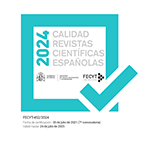La impronta del homo pneumaticus en el retrato tardorromano
Resumen
Se ha dicho, y tal vez con razón, que el retrato romano fisionómico es una de las grandes aportaciones que nos ha legado Roma, junto con la Arquitectura y el Derecho, ya que a través del mismo nos dejó escrita la crónica del devenir de su pensamiento y de su Historia. En los siglos III y IV, el ciudadano romano tuvo que enfrentarse a una grave crisis de principios políticos y creencias religiosas, por lo que se vio obligado a reconstruirse por dentro de acuerdo con una postura íntima, sin renunciar a las exigencias del conocimiento (gnosis). Surgió así la figura del llamado “hombre espiritual” (homo pneumaticus), seguidor, en muchos casos, de las corrientes neoplatónicas impulsadas por el filósofo Plotino. Sus dudas e inquietudes se reflejaron en una serie de retratos en los que, de modo intencionado, por medio de determinados rasgos estilísticos, se dejó sentir la impronta de la situación anímica imperante en esta época.
Descargas
Descarga artículo
Licencia
La revista Cuadernos de Filología Clásica. Estudios griegos e indoeuropeos, para fomentar el intercambio global del conocimiento, facilita el acceso sin restricciones a sus contenidos desde el momento de su publicación en la presente edición electrónica, y por eso es una revista de acceso abierto. Los originales publicados en esta revista son propiedad de la Universidad Complutense de Madrid y es obligatorio citar su procedencia en cualquier reproducción total o parcial. Todos los contenidos se distribuyen bajo una licencia de uso y distribución Creative Commons Reconocimiento 4.0 (CC BY 4.0). Esta circunstancia ha de hacerse constar expresamente de esta forma cuando sea necesario. Puede consultar la versión informativa y el texto legal de la licencia.










